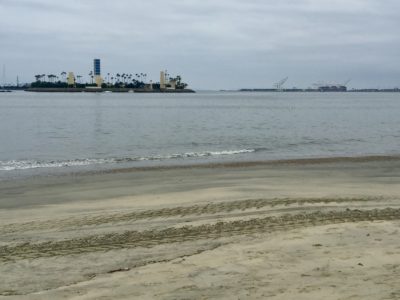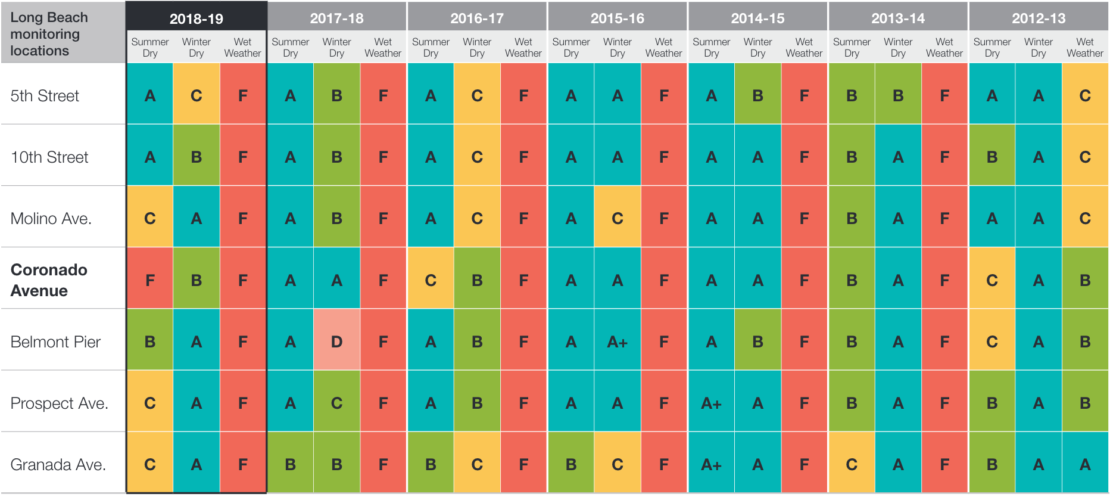A stretch of beach off Coronado Avenue just north Belmont Pier has been ranked as fourth dirtiest in the state when it comes to water quality, according to an annual report released Wednesday from Heal the Bay.
Aided by the unusually wet winter, Los Angeles and Orange counties combined to earn five spots on the environmental group’s list of the state’s 10 worst beaches. The ‘Beach Bummer’ list was released as part of Heal the Bay’s 29th annual Beach Report Card.
The top spot for worst water quality this year went to the beach at San Clemente Pier in Orange County. Clam Beach in Humboldt County came in second, followed by Linda Mar Beach in San Mateo County.
The beach near Coronado Avenue, which sees runoff from a nearby storm drain, made its first-ever appearance on the list, with an “F” grade for both dry summer and wet winter months, according to the report.

But it wasn’t all bad for Long Beach. Colorado Lagoon was noted this year for its significant improvements.
Prior to 2012, Colorado Lagoon was a chronic ‘beach bummer.’ But the lagoon’s water quality has greatly improved thanks to ongoing restoration projects over the past decade, including new landscaping to catch runoff from the neighboring golf course, a trash catch basin and the removal of thousands of pounds of polluted sediment.
The restoration project’s second phase will open the lagoon to the ocean at Marine Stadium to improve water circulation and restore wetland habitats.
While Coronado Beach ranked at the bottom, other local beaches in Long Beach fared better this year:

The report noted that Long Beach is currently developing the Municipal Urban Stormwater Treatment (MUST) project, set to be built on the Los Angeles River south of Shoemaker Bridge.
Billed as one of the first of its kind in size for a city, the $30 million project will use underground pipes to capture and treat stormwater runoff that would normally be lost in the Los Angeles River. The water can then be used to preserve and restore coastal wetlands.
In another major storm water project, Los Angeles County is currently building large galleries underneath the Long Beach Airport to capture runoff from surrounding Signal Hill and Long Beach streets.
Once completed, the project will be able to capture more than 33 acre-feet of stormwater, which can be cleaned and used to recharge local groundwater. One acre foot of water is equal to about 326,000 gallons, which can sustain two average households for a year.
The report Wednesday noted that many beaches have seen improvements.
Orange County had 10 beaches listed on the group’s Honor Roll. Los Angeles County earned two spots on the Honor Roll—down from eight last year. The ocean side of Cabrillo Beach in San Pedro made the grade, as did Las Tunas County Beach at Pena Creek in Malibu.
According to the report, 95 percent of Southern California beaches received A or B grades for water quality during the dry summer weather. But it emphasized the negative impact of wildfires and rainy weather during the winter across the state.
“California experienced a disproportionate amount of rain and wildfires over the last year, which came with below-average wet-weather grades in 13 out of 17 coastal counties and far below average grades at Malibu beaches where the Woolsey Fire burned,” according to the report.
The report calls on the state to improve efforts to capture stormwater and treat it for reuse instead of allowing it to run into the ocean.
– City News Service contributed to this report
Editor’s Note: An earlier report incorrectly stated that Colorado Lagoon was on Heal the Bay’s “Honor Roll” list.

